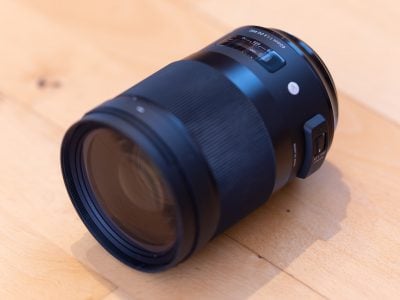Sigma 40mm f1.4 Art review
-
-
Written by Thomas
Quality
Testing: Longitudinal Chromatic Aberration and focus shift
Lenses with focal ratios of f2.8 or larger are often prone to longitudinal color aberrations (loCA, a.k.a. “axial color” or “Bokeh CA”). These normally show up as magenta coloration in the foreground and greenish hues in the background and are not easily corrected in post-processing. But the Sigma 40mm f1.4 Art is very good in this respect: it shows very little loCA even wide open. The following 100% crops show the foreground on the left and the background on the right with the first crop at f1.4, second at f2.0, third at f2.8:
Longitudinal Chromatic Aberration (loCA)
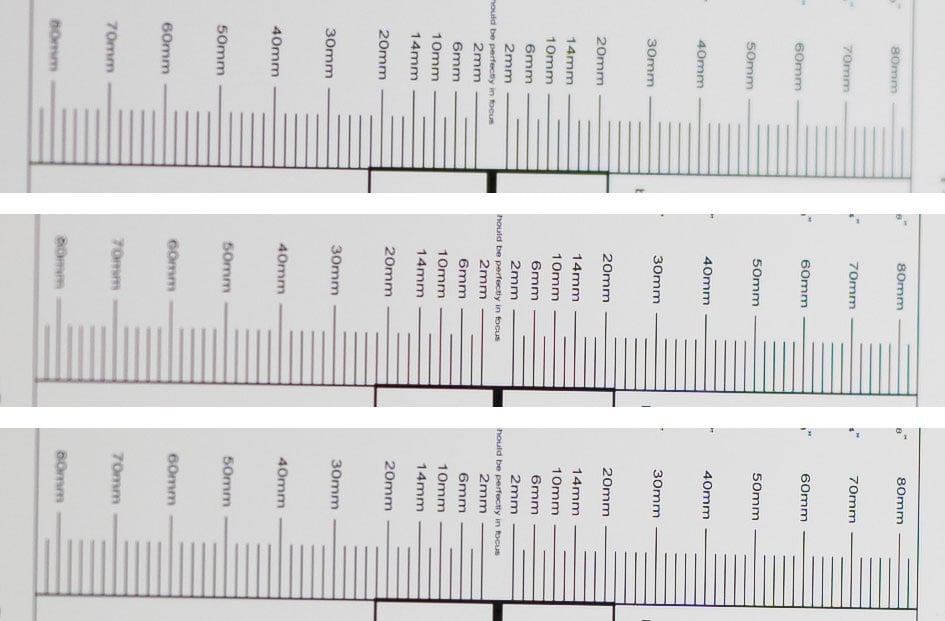
Above: Sigma 40mm f1.4 Art at f1.4, f2.0, f2.8; 100% crops
As you can see in the following example there is no discernible coloration around the foreground or background branches:

Above: Sigma 40mm f1.4 Art at f1.4; 100% crop; click image to access 4k version
But the test also revealed that there is quite some focus shift away from the camera when stopping down: see how the text on the left side from “60mm” to “30mm” clearly becomes less sharp when the lens is stopped down from f1.4 to f2.0. This is the biggest optical flaw of the lens and can show up at every focus distance. Fortunately this problem is taken care of when focusing using the actual aperture like when shooting video or using the lens on a modern mirrorless body. But when shooting photos on a DSLR using phase-detect autofocus at the largest aperture it can be a problem shooting at f2.0 and f2.8.
The Zeiss 40mm f2.0 Batis also has very little loCA (see here, crops are f2.0, f2.8, f4) while the Sony 35mm f1.4 ZA (here) shows the effect pretty prominently.
Sharpness and contrast
Let’s have a look at the theoretical performance of the Sigma 40mm f1.4 Art first and compare it to the alternatives from Zeiss and Sony:
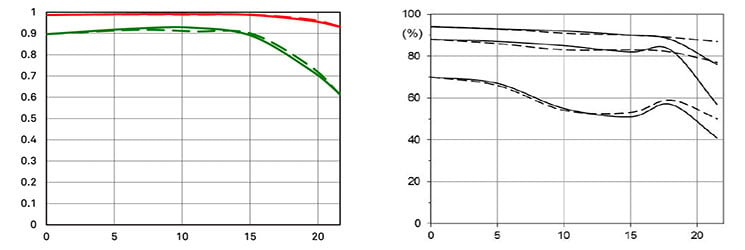
Above: MTF Sigma 40mm f1.4 Art (left), Zeiss 40mm f2.0 Batis (right)
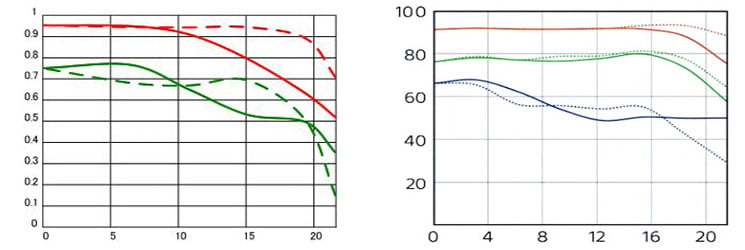
Abovet: MTF Sigma 35mm f1.4 Art (left), Sony 35mm f1.4 ZA (right)
The computed MTF charts from both Sigmas show contrast at 10 line-pairs per mm and 30 lp/mm at f1.4 without influence of diffraction. Higher values are better (more contrast) and the closer the line-pairs are together the less astigmatism (= resolution depends on the orientation of the test-pattern) the lens has. The MTF chart of the Zeiss (designed) lenses shows the measured contrast wide open at 10, 20 and 40 lp/mm. This includes the influence of diffraction . The x-axis displays the distance from the optical axis (=center of the sensor) in mm. I’ll show you the real-life performance at 4 mm (center), 13 mm (APS-C-corner), and 20 mm (FF-corner) on a 46MP Nikon Z7 and a 42MP Sony A7R II body.
From the charts the Sigma 40mm f1.4 Art looks clearly better than every other lens in this comparison. Especially noteworthy is the difference against its shorter sibling in Sigma’s Art series, the 35mm f1.4 Art, which shows quite some astigmatism and a distinct drop in resolution at the APS-C-corner and then again towards the FF-corner. Both Zeiss (designed) lenses seem to perform somewhere between the 40mm f1.4 Art and the 35mm f1.4 Art. Keep in mind though that the Zeiss Batis is shows here at f2.0 with all the others at the more demanding f1.4. But let’s see how this theoretical performance of the Sony translates into real life results in the sharpness test based on Siemens-stars. Processing was done in Lightroom 8/CRAW 11 from RAW to Adobe Color profile with the built-in lens profile applied. Noise-reduction is set to 0, sharpening to 50/0.5/36/10, with no extra tone, color, or saturation adjustment. White-balance was adjusted to a neutral white and I did some exposure compensation to make the brightness of all crops match. So you will not see light fall-off in the corners.
The following 100% crops show the Sigma 40mm f1.4 Art shot on a 46MP Nikon Z7 (with FTZ-adapter) from f1.4 down to f11 compared to the Sony 35mm f1.4 ZA shot on a 42MP Sony A7R II and the Sigma 35mm f1.4 Art shot on a 36MP Nikon D800 at f1.4 plus the Zeiss 40mm f2.0 Batis at f2.0 (which was shot on the Sony A7R II). Linear resolution of the Z7 sensor is only 4% higher than from the Sony A7R II and of the D800 sensor 7% lower which should not make a distinct difference in this comparison. The Sigma 35mm f1.4 Art had no lens profiles applied but I increased sharpening to 70/0.5/36/10 to counteract the slightly softening effect of the AA-filter in the D800.
Sigma 40mm f1.4 Art; 100% crop from center, APS-C/DX-corner, FF/FX-corner

Above: Sigma 40mm f1.4 Art at f1.4

Above: Sony 35mm f1.4 ZA on a 42MP Sony A7R II at f1.4; also available at f2.0, f2.8, f4.0, f5.6, f8.0, f11

Above: Sigma 35mm f1.4 Art on a 36MP Nikon D800 at f1.4
In this comparison at f1.4 the Sigma 40mm f1.4 Art shows very good performance across the sensor. It also had no field-curvature, all crops were taken from the same shot without the need to re-focus. The Sony 35mm f1.4 ZA is also very sharp in the center but its corners look mushy in comparison. The Sigma 35mm f1.4 Art is slightly softer in the center but has an astonishingly good FF-corner. Unfortunately its APS-C-corner suffers from astigmatism.
Let’s do the same comparison at f2.0 now including the Zeiss Batis:

Above: Sigma 40mm f1.4 Art at f2.0

Above: Zeiss 40mm f2.0 Batis on a 42MP Sony A7R II at f2.0; also available at f2.8, f4.0, f5.6, f8.0, f11

Above: Sony 35mm f1.4 ZA on a 42MP Sony A7R II at f2.0

Above: Sigma 35mm f1.4 Art on a 36MP Nikon D800 at f2.0
The Zeiss Batis is almost as sharp in the center and the FF-corner as the Sigma 40mm f1.4 Art but its APS-C-corner is clearly softer. The Sony ZA continues to suffer from soft corners and the Sigma 35mm f1.4 Art still shows strong astigmatism in the APS-C-corner which is even softer than from the Sony ZA.
Now let’s see how the Sigma 40mm f1.4 Art develops when stopped down further:

Above: Sigma 40mm f1.4 Art at f2.8

Above: Sigma 40mm f1.4 Art at f4.0

Above: Sigma 40mm f1.4 Art at f5.6

Above: Sigma 40mm f1.4 Art at f8.0

Above: Sigma 40mm f1.4 Art at f11
Stopping Sigma’s 40mm f1.4 Art further down continues the excellent performance of the lens until you clearly get softening from diffraction at f11.
Performance at long distances
The Siemens-star test-targets are shot at a distance of 45x focal length (i.e. at around 1.8m). But as performance of lenses also depends on the shooting distance I did another series of test-shots of a city around 1 km away. Processing was done in Lightroom 8/CRAW 11 from RAW to Adobe Color profile with the lens-profile automatically applied. Noise-reduction is set to 0, sharpening to 50/0.5/36/10, with no extra tone, color, or saturation adjustment. I used autofocus at the largest aperture and did not change focus for other apertures. All shots of the Sigma 40mm f1.4 Art were made on a 46MP Nikon Z7 (with FTZ-adapter) at ISO 64 and image stabilization switched off.
The main image shows the complete scene wide open to give you an impression of the angle of view and to judge vignetting. You can access the respective shots up to f11 via the links beneath the main image. Following the main image are 100% crops from the Sigma 40mm f1.4 Art down to f11 compared to the Sony 35mm f1.4 ZA at f1.4 plus the Zeiss 40mm f2.0 Batis at f2.0 shot on a 42MP Sony A7R II at ISO 100. All three lenses were shot on the same day only minutes apart. The small differences in linear resolution between the Nikon and the Sony camera should not make a visible difference.
You can click on each image to access the large original. Please respect our copyright and only use those images for personal use.
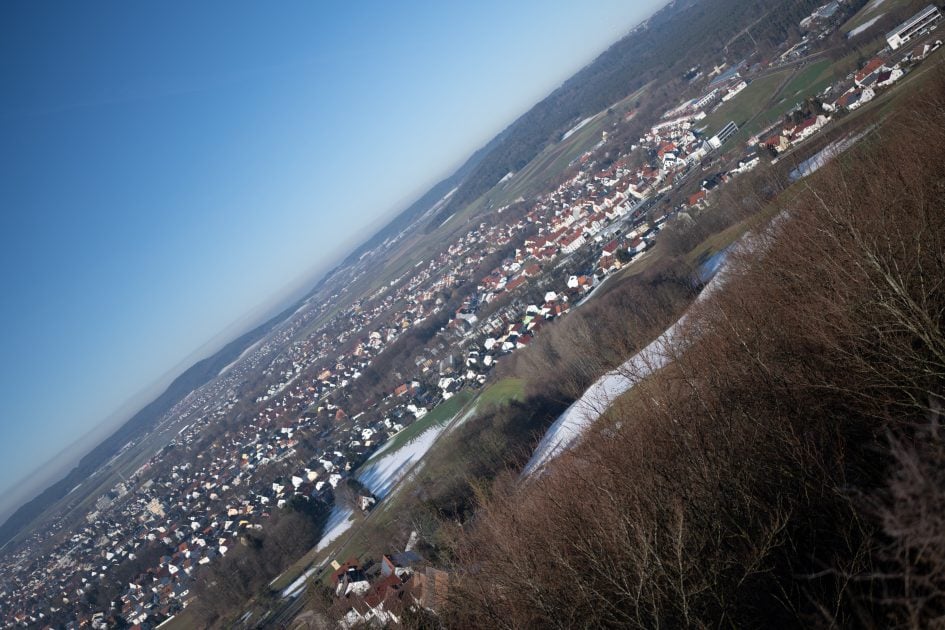
Above: Sigma 40mm f1.4 Art at f1.4; click image for 4k version, also available as large original at f1.4, f1.6, f1.8, f2.0, f2.8, f4.0, f5.6, f8.0, f11

Above: Sigma 40mm f1.4 Art at f1.4; 100% crop from center, APS-C-corner, FF-corner

Above: Sony 35mm f1.4 ZA on a 42MP Sony A7R II at f1.4; 100% crop from center, APS-C-corner, FF-corner; click image to access original at Flickr; also available at f1.6, f1.7, f2.0, f2.8, f4.0, f5.6, f8.0, f11
At f1.4 the Sigma 40mm f1.4 Art again resolves very fine details across the sensor but the center crop suffers from some glare that makes bright areas bleed a little into dark ones reducing the overall contrast a bit. The Sony ZA looks a tad softer towards the corners and shows some magenta and green outlining along high contrast edges in the center.
Let’s repeat the comparison at f2.0 now including the Zeiss Batis:

Above: Sigma 40mm f1.4 Art at f2.0; 100% crop from center, APS-C-corner, FF-corner

Above: Zeiss 40mm f2.0 Batis on a 42MP Sony A7R II at f2.0; 100% crop from center, APS-C-corner, FF-corner; click image to access original at Flickr; also available at f2.8, f4.0, f5.6, f8.0, f11

Above: Sony 35mm f1.4 ZA on a 42MP Sony A7R II at f2.0; 100% crop from center, APS-C-corner, FF-corner
At f2.0 the Sigma Art produces a very contrasty center while the APS-C-corner does not seem to profit much from stopping down. That may be the result of focus shift. The Zeiss Batis shows a very respectable performance even surpassing the Sigma Art in the APS-C-corner. The Sony ZA has now shed the colorful outlining and produces a very sharp center and a pretty good FF-corner only slightly behind the Zeiss Batis. But its APS-C-corner is even less well defined than from the Sigma Art as field curvature bends the focal plane towards the camera (see the sharp looking branch in the foreground of the middle crop).
Following is how the Sigma 40mm f1.4 Art develops when stopped down:

Above: Sigma 40mm f1.4 Art at f2.8; 100% crop from center, APS-C-corner, FF-corner

Above: Sigma 40mm f1.4 Art at f4.0; 100% crop from center, APS-C-corner, FF-corner

Above: Sigma 40mm f1.4 Art at f5.6; 100% crop from center, APS-C-corner, FF-corner

Above: Sigma 40mm f1.4 Art at f8.0; 100% crop from center, APS-C-corner, FF-corner

Above: Sigma 40mm f1.4 Art at f11; 100% crop from center, APS-C-corner, FF-corner
At f2.8 the APS-C-corner of the Sigma 40mm f1.4 Art snaps back into sharp focus and the lens continues its excellent performance across the sensor until diffraction takes its toll at f11.
Rendering of point-light sources at night-shots
Night-shots pose a different challenge for lenses as the contrast is even higher than under bright sun and point-light sources can reveal some weaknesses such as coma, haloing and color-aberrations that do not show up as prominently in other test-shots. The 100% crops below the main image show the effect of coma in the FF-corner of the Sigma 40mm f1.4 Art, Zeiss Batis, Sony ZA and Zeiss Otus at various apertures:
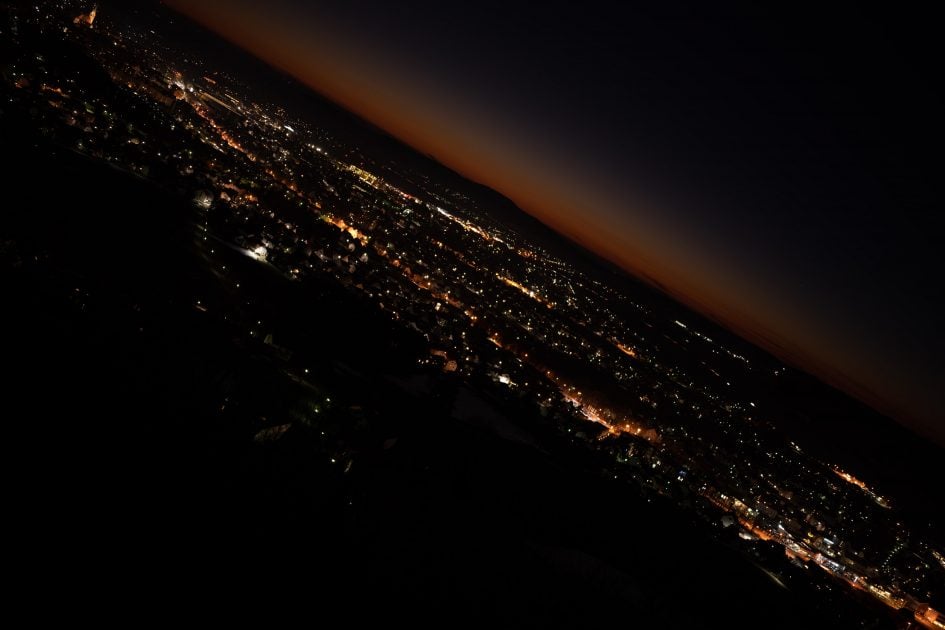
Above: Sigma 40mm f1.4 Art at f1.4; click image for 4k version, also available as large original at f1.4, f1.6, f1.8, f2.0, f2.8, f4.0, f5.6, f8.0

Above: Sigma 40mm f1.4 Art; 100% crops from the FF-corner at f1.4 (left), f2.0 (middle), f2.8 (right)

Above: Zeiss 40mm f2.0 Batis on a 42MP Sony A7R II; 100% crops from the FF-corner at f2.0 (left), f2.8 (middle), f4.0 (right)

Above: Sony 35mm f1.4 ZA on a 42MP Sony A7R II; 100% crops from the FF-corner at f1.4 (left), f2.0 (middle), f2.8 (right)
The Sigma 40mm f1.4 Art produces almost no coma wide open – very good! Both the Zeiss Batis (at f2.0) and the Sony ZA (at f1.4) show some coma albeit not a very strong one. The only deficiency I can find with the Sigma Art is that it shows a little blooming around bright lights at f1.4:

Above: Sigma 40mm f1.4 Art at f1.4 (left) and f1.6 (right); 100% crop
This is the same effect that reduces the edge acuity in the f1.4 shot at daylight. Fortunately the halos are not colored by loCA and are thus pretty unobtrusive. And the effect is reduced considerably at f1.6 already.
Rendering of out-of-focus point-light sources
This test is for the rendering of point-light sources in an out-of-focus background. The circle of confusion that is produced by this test is pretty indicative of Bokeh performance (in the background) and light fall-off. Ideally the out-of-focus image of the point-light is evenly lit and perfectly circular, with no “onion-rings”, and without coloration. Large aperture lenses normally produce an effect known as “cat’s eye” the further away from the optical axis the point-light is projected. This is due to optical vignetting in the lens barrel when light enters the lens from an angle.
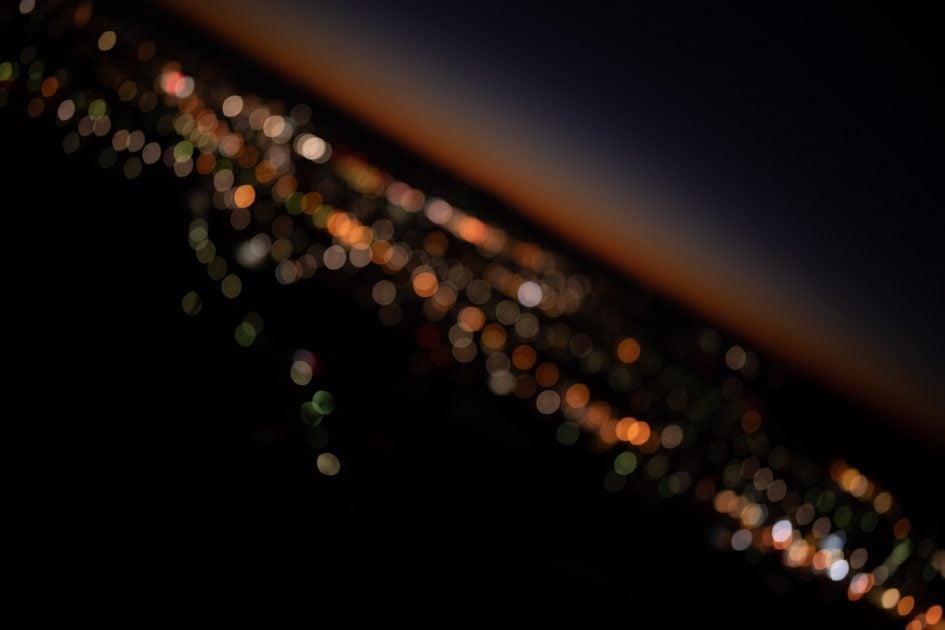
Above: Sigma 40mm f1.4 Art at f1.4; click image for 4k version, also available as large original at f1.4, f1.6, f1.8, f2.0, f2.8, f4.0, f5.6, f8.0

Above: Sigma 40mm f1.4 Art at f1.4; 44% crops from center, APS-C-corner, FF-corner

Above: Zeiss 40mm f2.0 Batis on a 42MP Sony A7R II at f2.0; 46% crops from center, APS-C-corner, FF-corner; also available at f2.8, f4.0, f5.6, f8.0

Above: Sony 35mm f1.4 ZA on a 42MP Sony A7R II at f1.4; 46% crops from center, APS-C-corner, FF-corner; also available at f1.6, f1.7, f2.0, f2.8, f4.0, f5.6, f8.0
Of the three lenses in this comparison the Sigma clearly produces the nicest, smoothest Bokeh balls with no onion rings and only a little outlining that shows no coloration from loCA. Both the Zeiss Batis and the Sony ZA show visible onion-rings and the Zeiss has also some outlining. Compression of the Bokeh balls is visible in the APS-C-corner already with all three lenses but the Zeiss Batis retains a more circular form while the Sigma Art and the Sony ZA produce the typical cat’s eye. As the size of the Bokeh balls in the center crop of a lens is directly proportional to the entrance pupil the Sigma Art is in the lead here with the Sony ZA producing 12% smaller Bokeh balls. The Zeiss Batis has 1/3 smaller Bokeh balls due to its f2.0 focal ratio. The image above shows even smaller balls as I did not set the focus correctly for this comparison.
Let’s see how this analysis of out-of-focus point-light sources translates into Bokeh-performance shooting a book-shelf.
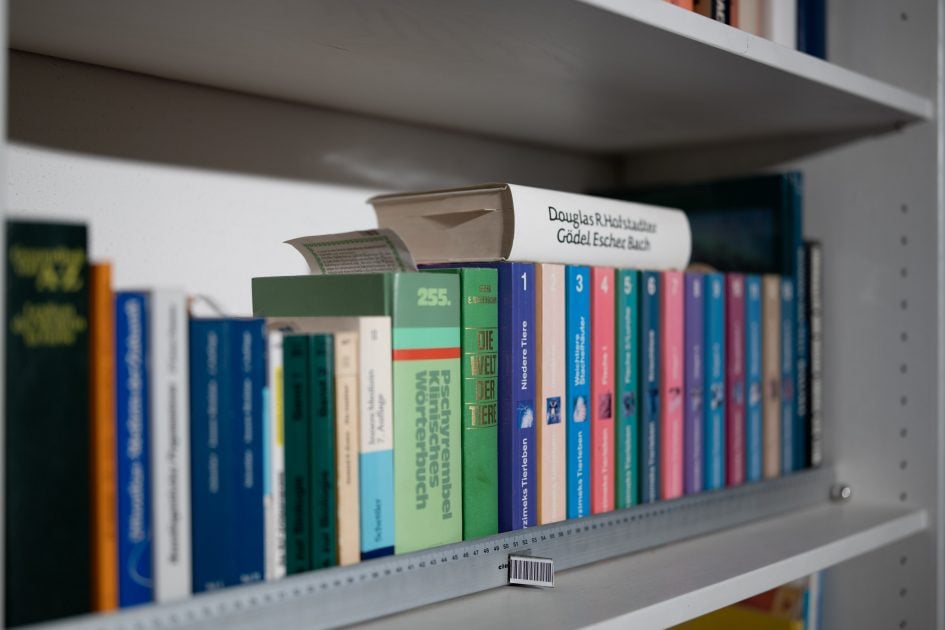
Above: Sigma 40mm f1.4 Art at f1.4; click image for 4k version, also available as large original at f1.4, f1.8, f2.0, f2.8, f4.0, f5.6, f8.0

Above: Sigma 40mm f1.4 Art at f1.4; 44% crops from foreground, middle-ground, background

Above: Zeiss 40mm f2.0 Batis on a 42MP Sony A7R II at f2.0; 46% crops from foreground, middle-ground, background; also available at f2.8, f4.0, f5.6, f8.0

Above: Sony 35mm f1.4 ZA on a 42MP Sony A7R II at f1.4; 46% crops from foreground, middle-ground, background; also available at f1.7, f2.0, f2.8, f4.0, f5.6, f8.0
From the comparison above it is clear that the Sigma 40mm f1.4 Art has the best Bokeh of the bunch: The transition zone is soft and without coloration and the background is smooth and creamy. Only the less important foreground is a bit nervous. The Zeiss Batis again is hampered by its f2.0 focal ratio that simply cannot compete with f1.4 lenses. The Sony ZA is more like the Sigma Art but is a little harsher in the middle-ground and background.
Close-up performance
The Sigma 40mm f1.4 Art goes down to 1:5.6 magnification which is similar to the Sony ZA. Only the Zeiss Batis delivers a much greater magnification of 1:3.1. The center performance of the Sigma Art in close-up shooting is pretty good once you stop down f2.8. But for the outer areas to catch up you need to stop the lens down to f5.6. The following image was shot at 1:5.9 magnification where the area of sharp focus is just 142 x 212mm. The crops shown below are (from left to right) from the center, 9mm, and 18mm off the center of the sensor respectively:

Above: Sigma 40mm f1.4 Art at f1.4, 1:5.9 magnification; 100% crops

Above: Sigma 40mm f1.4 Art at f2.8, 1:5.9 magnification; 100% crops

Above: Sigma 40mm f1.4 Art at f5.6, 1:5.9 magnification; 100% crops
Flare, ghosting, and sun-stars
Catching a strong light-source shining directly into the lens is always a risky business: it could produce strange colorful ghost-images or reduce contrast considerably through flare and glare. The appearance of flare and ghosting depends on factors like the aperture and the angle of the light hitting the lens. So to judge the proclivity of the Sigma 40mm f1.4 Art for these artifacts I went through a series of well calculated shots against a strong light source to provoke glare and ghosting.
The Sigma 40mm f1.4 Art is not very prone to flare and ghosting artifacts. The following image at f11 is one of the most obvious examples:
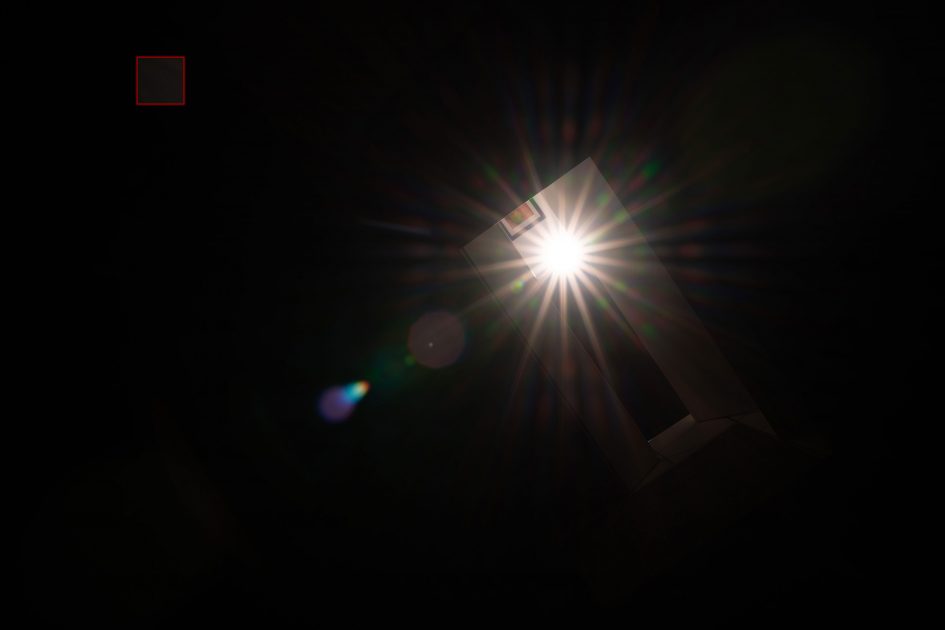
Above: Flare and ghosting. Strong light hitting the Sigma 40mm f1.4 Art at f11; click image for 4k version
The little square inset in the upper left of the image shows the respective area with an exposure compensation of +3 EV to make it easier to see which levels of black the lens renders at that point. It clearly shows that the Sigma 40mm f1.4 Art renders a very deep black against contra light. And when the light-source is just outside the corner the resulting streak is very mild (see upper right corner):
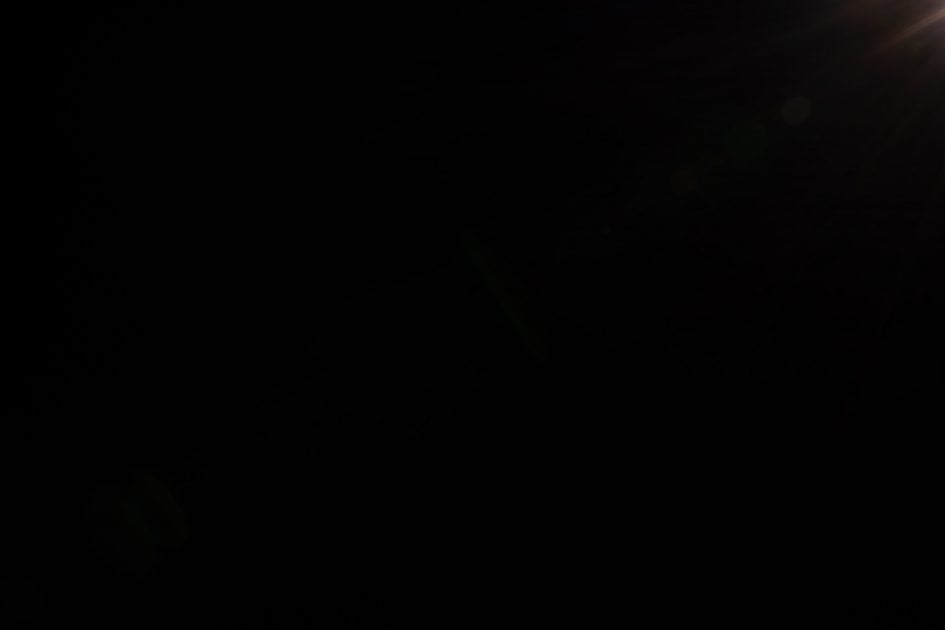
Above: Flare and ghosting. Strong light hitting the Sigma 40mm f1.4 Art at f11; click image for 4k version
All-in-all the Sigma Art let’s you shoot confidently under adverse contra-light situations. The only drawback being that the Nikon Z7 body might add some colorful “teardrops” to very bright sunstars as can be seen above. The coloration cannot be seen though with less bright light sources as the example below shows:

Above: Sunstars from the Sigma 40mm f1.4 Art at f5.6 (left) and f8.0 (right), 100% crops
Next check out my sample images!
Check prices on the Sigma 40mm f1.4 ART at Amazon, B&H, Adorama or WEX! Alternatively get yourself a copy of my In Camera book or treat me to a coffee! Thanks!




